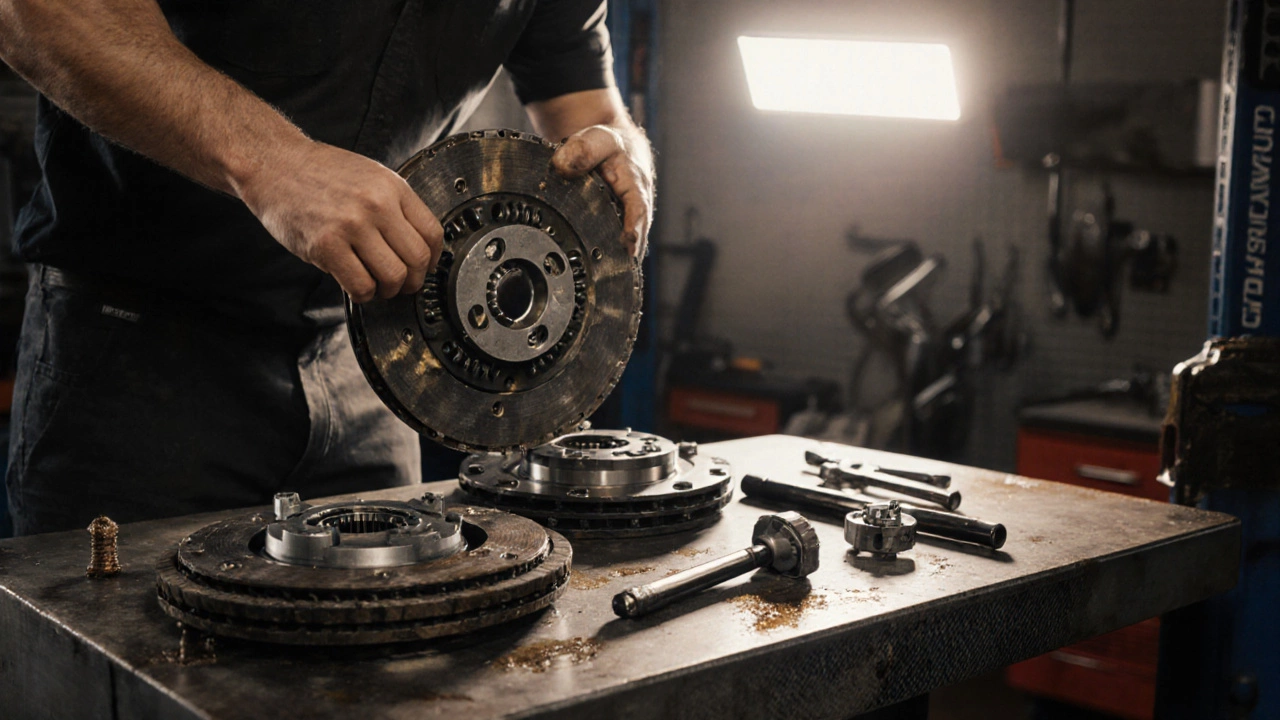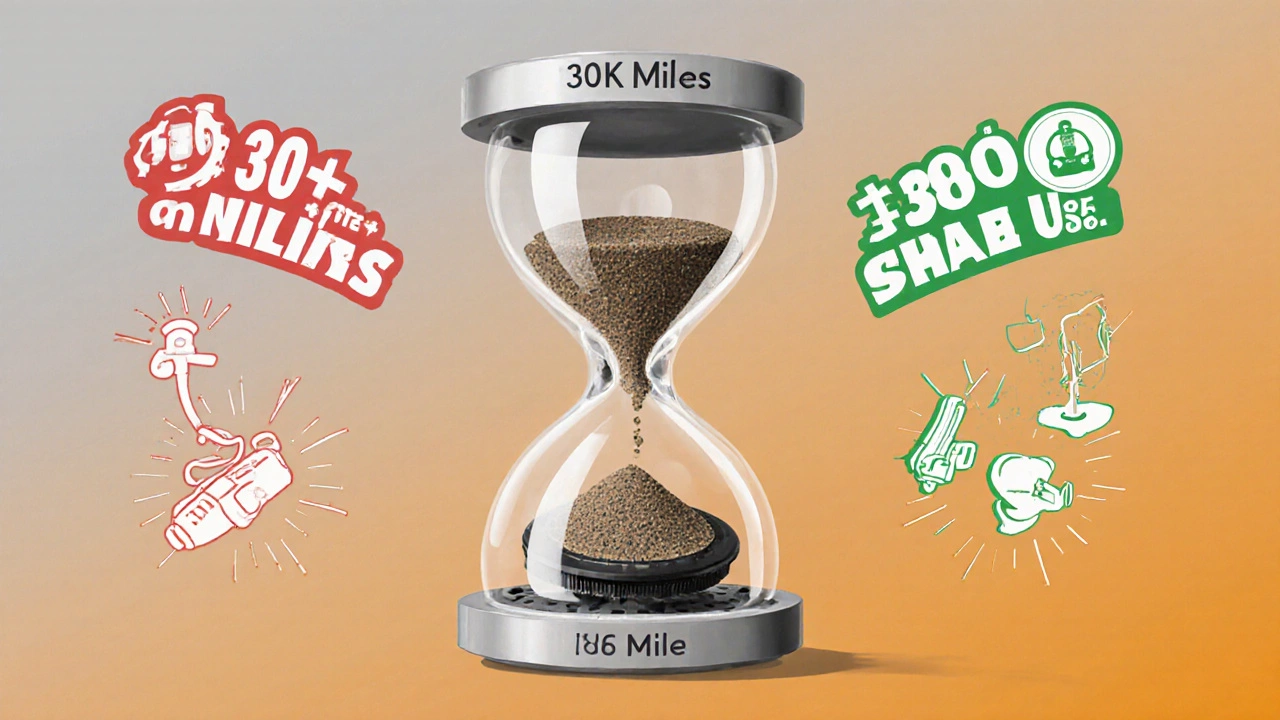 Oct, 29 2025
Oct, 29 2025
Clutch Lifespan Calculator
How Your Driving Affects Clutch Life
Clutch lifespan varies from 30,000 to 180,000+ miles based on driving habits. This tool estimates your clutch's remaining life.
Your Estimated Clutch Lifespan
Based on your habits and vehicle type, this estimate assumes no major issues.
Most drivers assume their clutch will last the life of the car. That’s not true. A clutch isn’t a forever part. It wears out. And when it does, you’re looking at a $1,200 to $2,500 repair-not because you did something wrong, but because it’s just physics. So how many miles does a clutch last? The short answer: clutch life varies wildly, from 30,000 miles to over 150,000 miles. But knowing why that range exists helps you avoid surprise breakdowns and costly mistakes.
What Actually Wears Out in a Clutch?
The clutch isn’t one part. It’s a system: the clutch disc, pressure plate, release bearing, and flywheel. The disc is the part that wears. It’s made of friction material-similar to brake pads-pressed between the flywheel and pressure plate. Every time you let the clutch out slowly, especially from a stop, that friction material rubs against metal. That’s normal. But the more you ride the clutch, the faster it goes.
Think of it like brake pads. If you drive with your foot lightly on the brake pedal all the time, you’ll wear them out in 20,000 miles. Same with the clutch. If you use it as a footrest, or hold the car on a hill with the clutch instead of the brake, you’re cooking it.
Typical Clutch Mileage: What’s Normal?
There’s no single number. But here’s what most mechanics in Hamilton see on the lift:
- 30,000 to 60,000 miles: Common in city drivers with heavy traffic, aggressive stop-and-go habits, or those who ride the clutch.
- 80,000 to 120,000 miles: Average for mixed driving-some highway, some city, moderate habits.
- 120,000 to 180,000+ miles: Happens with highway-heavy driving, smooth shifts, and drivers who never let the clutch slip intentionally.
Some manual transmission vehicles, like older Volkswagens or Mazdas, are known to hit 200,000 miles on the original clutch. Others, like heavy-duty trucks or performance cars with aggressive clutches, might fail before 50,000 miles. It’s not about the car brand-it’s about how you drive.
Driving Habits That Kill Clutches Fast
Here’s what actually shortens clutch life-not age, not time, but behavior:
- Riding the clutch: Keeping your foot on the pedal while stopped, even slightly. This keeps the release bearing engaged and the disc partially slipping.
- Launching hard: Flooring it from a stop with the clutch barely engaged burns the friction material instantly. This is common with sports cars and modified vehicles.
- Using the clutch to hold on hills: Instead of using the brake, you hold the car with the clutch. That’s constant slipping. Over time, it turns the disc into a paper-thin shell.
- Shifting too slowly: Letting the clutch pedal up too slowly while giving gas means the disc spins slower than the engine. That’s friction. That’s heat. That’s wear.
One mechanic I know in Hamilton says he sees the same pattern every winter: people who use their clutch to creep forward in snow or ice. That’s a death sentence. The clutch isn’t designed for that. Use the brake and gas gently.

Signs Your Clutch Is Wearing Out
You don’t need to wait for it to fail completely. These are the real warning signs:
- Slipping: The engine revs up, but the car doesn’t accelerate. Happens most under load-like going uphill or accelerating hard.
- Soft or spongy pedal: The clutch pedal feels easier to push, or you have to press it closer to the floor to get engagement.
- Grinding noises: Not just when shifting-grinding when you press the pedal down or let it up. That’s usually the release bearing failing.
- Unusual smells: A burning odor, like overheated brakes or hot plastic. That’s the friction material cooking.
- Difficulty shifting: Gears feel harder to get into, or the car lurches when you shift.
If you notice any of these before 80,000 miles, don’t ignore it. A slipping clutch won’t fix itself. It’ll get worse. And if you keep driving, you can damage the flywheel-which adds $300 to $600 to your repair bill.
Clutch Kits: What’s Included and What You Should Know
When you replace a clutch, you don’t just buy a disc. You buy a clutch kit. That includes:
- Clutch disc
- Pressure plate
- Release bearing (or throw-out bearing)
- Alignment tool (sometimes)
Some kits include a new pilot bearing or a resurfaced flywheel. But most don’t. That’s a mistake. If your flywheel is worn, glazed, or cracked, installing a new clutch on it is like putting new tires on a bent rim. It won’t last.
Always ask: Is the flywheel being inspected? Is it being resurfaced or replaced? A good shop will check it. A cheap one won’t. And you’ll be paying for the same job again in 20,000 miles.
How to Make Your Clutch Last Longer
You don’t have to drive like a grandma to get 150,000 miles out of a clutch. Just avoid these three things:
- Never rest your foot on the clutch pedal. Keep it off unless you’re shifting.
- Shift smoothly. Don’t rush. Don’t drag. Match engine revs slightly when downshifting.
- Use the brake, not the clutch, to hold on hills. It’s safer, easier, and preserves the clutch.
Also, get your clutch fluid checked if you have a hydraulic system. Low fluid or air in the lines can make shifting feel off and cause premature wear.

When to Replace It: Don’t Wait for Failure
Waiting until the clutch dies is expensive. If you’re at 90,000 miles and you notice slipping, don’t wait. If you’re at 120,000 miles and the pedal feels different, get it checked. Replacing a clutch is a labor-heavy job. It takes 5 to 8 hours. You’re paying for the mechanic’s time. You might as well do it right.
And if you’re planning to keep the car past 100,000 miles, replacing the clutch before it fails is smart. You avoid being stranded. You avoid damaging other parts. You save money in the long run.
What About Clutch Kits for Performance or Towing?
If you tow trailers, haul heavy loads, or drive a modified car, your stock clutch won’t cut it. You need a heavy-duty clutch kit. These use stronger pressure plates and more aggressive friction material. But here’s the catch: they’re stiffer. They’re harder to drive in traffic. They’re not for daily commuting.
Most people who install a performance clutch without realizing the trade-off end up regretting it. The clutch doesn’t last longer-it just handles more torque. But if you drive gently, even a performance clutch will wear out faster than a stock one because of the harder engagement.
Only upgrade if you’re towing over 5,000 pounds or running a tuned engine. Otherwise, stick with OEM.
Final Thoughts: It’s Not About the Mileage-It’s About the Driving
There’s no magic number for clutch life. A 2015 Honda Civic with 180,000 miles on the original clutch? Possible. A 2020 Ford Focus with 40,000 miles and a burned-out clutch? Also possible. It’s not about the car. It’s about the driver.
Clutches are designed to wear. That’s how they work. But you control how fast they wear. Drive with intention. Don’t abuse the pedal. Don’t treat it like a footrest. And if you notice any of the warning signs, get it checked before it leaves you stranded on the 401.
When in doubt, assume your clutch has 30,000 miles left. Check it. Then drive like you mean it-without killing your transmission.
How long does a clutch last on average?
On average, a clutch lasts between 80,000 and 120,000 miles. But this varies widely-some last under 30,000 miles with aggressive driving, while others reach 180,000 miles or more with careful use. Driving habits matter more than mileage or car brand.
Can a clutch last 200,000 miles?
Yes, but only under ideal conditions: mostly highway driving, smooth shifting, no clutch riding, and no heavy towing or performance modifications. Older manual cars like the Toyota Corolla, Honda Civic, or Volkswagen Golf are known to hit 200,000 miles on the original clutch when driven gently.
What causes a clutch to fail early?
The top causes are riding the clutch pedal, using the clutch to hold the car on hills, launching hard from stops, and shifting too slowly. These habits cause the friction material to overheat and wear down faster. Hydraulic issues like low fluid or air in the system can also contribute.
Is it worth replacing the flywheel when replacing the clutch?
Yes, if the flywheel shows signs of wear-glazing, scoring, or cracks. A worn flywheel will damage a new clutch quickly. Most mechanics recommend resurfacing or replacing the flywheel during a clutch job. Skipping this step can lead to premature clutch failure and extra costs later.
How much does it cost to replace a clutch?
Clutch replacement typically costs between $1,200 and $2,500, depending on the car. Labor makes up most of the cost-5 to 8 hours of work. Parts alone (clutch kit) range from $300 to $800. If the flywheel needs replacement, add $300 to $600. Performance clutches cost more but aren’t necessary for everyday driving.
Can you drive with a slipping clutch?
You can, but you shouldn’t. A slipping clutch puts extra stress on the transmission and can cause damage to the gearbox. It also gets worse quickly. Driving with a bad clutch risks being stranded and increases repair costs. Get it fixed before it fails completely.
Do clutch kits come with a warranty?
Most quality clutch kits come with a 12-month or 12,000-mile warranty. OEM parts often have longer coverage. Cheap aftermarket kits may offer little to no warranty. Always ask about warranty terms before buying. A good warranty reflects confidence in the product’s durability.